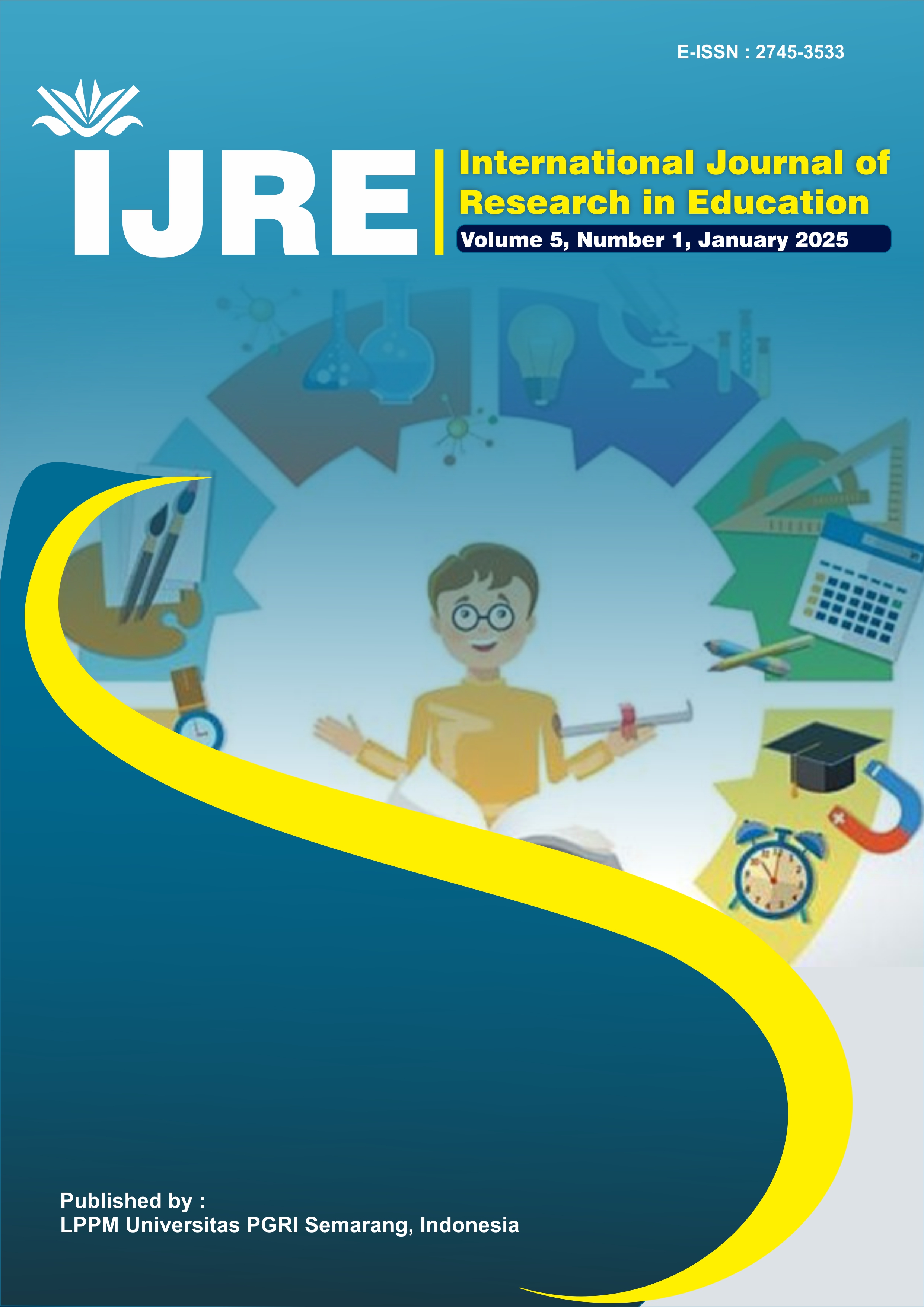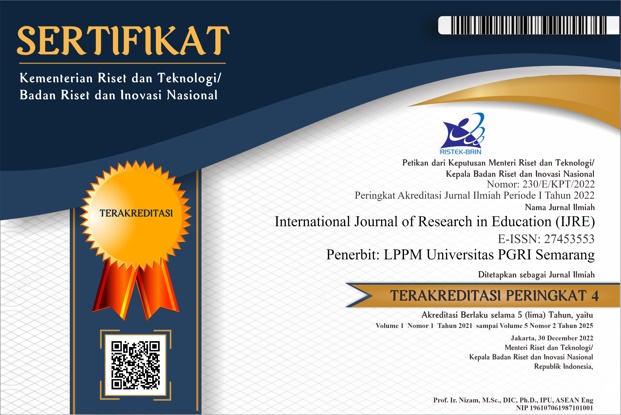How Stereotype Threat and Stress Affect Learning: From Theory to Empirical Evidence
DOI:
https://doi.org/10.26877/ijre.v5i1.1111Keywords:
Stereotype threat, Stress, LearningAbstract
Stereotype threat and stress are prevalent factors in education. Students experiencing one of these two psychological phenomena often demonstrate lower academic or learning performance. This article reviews and synthesizes some research findings, emphasizing on how stereotype threat and stress affect learning. It examines different domains, including science education such as mathematics and physics and second or foreign language learning. It also examines different demographic groups which include races, ethnic minority, gender and social class. By integrating theoretical perceptive with empirical evidence, this article offers a comprehensive overview of how stereotype threat and stress affect learning process and provides educators and parents with strategies of how to deal with threat and stress. The results of the analysis give some implications on learning in general and in language learning in particular.
References
Alqahtani, A. A., & Alajm, S. S. (2013). Psychological Stress in Language Learning: A Contemporary View beyond Teaching Methods. Journal of Education and Practice , 4(5), 168–171.
Aronson, J., Lustina, M. J., Good, C., Keough, K., Steele, C. M., & Brown, J. (1999). When White Men Can’t Do Math: Necessary and Sufficient Factors in Stereotype Threat. Journal of Experimental Social Psychology, 35(1), 29–46. https://doi.org/10.1006/jesp.1998.1371
Aronson, J., & McGlone, M. S. (2009). Stereotype and Social Identity Threat. In T. D. Nelson (Ed.), Handbook of Prejudice, Stereotyping, and Descrimination (2nd ed., pp. 153–178). Psychology Press.
Bazhouni, M. (2020, January 26). The Influence of Stereotype Threat on Non-Native Accented Speaker’s Communication Skills in Institutions of Higher Education . Awraqthaqafya.Com.
Birney, M. E., Rabinovich, A., Morton, T. A., Heath, H., & Ashcroft, S. (2020). When Speaking English Is Not Enough: The Consequences of Language-Based Stigma for Nonnative Speakers. Journal of Language and Social Psychology, 39(1), 67–86. https://doi.org/10.1177/0261927X19883906
Blumenthal, P., Britt, T. W., Cohen, J. A., McCubbin, J., Maxfield, N., Michael, E. B., Moore, P., Obler, L. K., Scheck, P., Signorelli, T. M., & Wallsten, T. S. (2006). Stress effects on bilingual language professionals’ performance. International Journal of Bilingualism, 10(4), 477–497. https://doi.org/10.1177/13670069060100040501
Brown, H. D. (2007). Principles of Language Learning and Teaching. Pearson.
Bruce, D. (2024, March 7). Defying Stereotypes: Seven Must-Know Tips for Non-Native English Speakers. LinkedIn.
Buchanan, T. W., Steele, S. C., Burnett, C. L., Awais, K., Appenzeller, M., Bosen, A. K., & Conway, C. M. (2024). - Chronic Stress, Hair Cortisol, and Language Performance in Children. Psychoneuroendocrinology, 160, 106824. https://doi.org/10.1016/j.psyneuen.2023.106824
Chaffee, K. E., Lou, N. M., & Noels, K. A. (2020). Does Stereotype Threat Affect Men in Language Domains? Frontiers in Psychology, 11. https://doi.org/10.3389/fpsyg.2020.01302
Cho, H. (2011, July 21). Study finds stereotyping affects minority learning. The Stanford Daily. .
Croizet, J.-C., & Claire, T. (1998). Extending the Concept of Stereotype Threat to Social Class: The Intellectual Underperformance of Students from Low Socioeconomic Backgrounds. Personality and Social Psychology Bulletin, 24(6), 588–594. https://doi.org/10.1177/0146167298246003
Dahmani, H., Chbir, Y. Ben, & Bayour, A. (2022). Gender gaps in English as a second foreign language attainment: some Oujda High Schools case study. Journal of Science and Education (JSE), 3(1), 13–22. https://doi.org/10.56003/jse.v3i1.126
Dörnyei, Z. (2005). The Psychology of the Language Learner: Individual Differences in Second Language Acquisition. In The Psychology of the Language Learner: Individual Differences in Second Language Acquisition. Lawrence Erlbaum Associates Publishers.
Fink, G. (2016). Stress, definitions, mechanisms, and effects outlined: lessons from anxiety Stress Concepts, Cognition, Emotion, and Behavior. ed. G. Fink . In G. Fink (Ed.), Stress Concepts, Cognition, Emotion, and Behavior (1st ed., Vol. 1, pp. 3–11). Elsevier Academic Press.
Flook, L., & Fuligni, A. J. (2008). Family and School Spillover in Adolescents’ Daily Lives. Child Development, 79(3), 776–787. http://www.jstor.org/stable/27563517
Gallagher, T. M. (1999). Interrelationships among Children’s Language, Behavior, and Emotional Problems. Topics in Language Disorders , 19(2), 1–15.
Goleman, D. (2017, December 6). What’s Your Stress Type? Huffpost.
Harrison, L. A., Stevens, C. M., Monty, A. N., & Coakley, C. A. (2006). The consequences of stereotype threat on the academic performance of White and non-White lower income college students. Social Psychology of Education, 9(3), 341–357. https://doi.org/10.1007/s11218-005-5456-6
Hashemi, M. (2011). Language Stress And Anxiety Among The English Language Learners. Procedia - Social and Behavioral Sciences, 30, 1811–1816. https://doi.org/10.1016/j.sbspro.2011.10.349
Hayat, A. A., Shateri, K., Amini, M., & Shokrpour, N. (2020). Relationships between academic self-efficacy, learning-related emotions, and metacognitive learning strategies with academic performance in medical students: a structural equation model. BMC Medical Education, 20(1), 76. https://doi.org/10.1186/s12909-020-01995-9
Heaning, E. (2023, October 10). Stereotype Threat: Definition and Examples. Simply Psychology.
Huang, Z. (2023). Exploring Gender Differences in Language Learning. In Proceedings of the 2nd International Conference on Education, Language and Art (ICELA 2022) (pp. 543–554). Atlantis Press SARL. https://doi.org/10.2991/978-2-38476-004-6_67
Jody, A. (2011, June 7). Interview: How Does Classroom Stress Affect Learning? Education Week.
König, S., Stang-Rabrig, J., Hannover, B., Zander, L., & McElvany, N. (2023). Stereotype threat in learning situations? An investigation among language minority students. European Journal of Psychology of Education, 38(2), 841–864. https://doi.org/10.1007/s10212-022-00618-9
Krashen, S. D., & Terrell, T. D. (1998). The Natural Approach: Language Acquisition in the Classroom. Prentice Hall Europe.
Kurniasih, S. K., Putro, N. H. P. S., & Sudiyono, S. (2020). Analysis of factors of students’ stress of the English Language Department. REID (Research and Evaluation in Education), 6(1), 66–77. https://doi.org/10.21831/reid.v6i1.29567
Kutuk, G. (2019). The Effects of Stereotype Threat on Foreign Language Performance through the Mediating Roles of Self-Efficacy and Anxiety . Edge Hill University .
Larsen-Freeman, D., & Anderson, M. (2011). Techniques and Principles in Language Teaching (3rd ed.). Oxford University Press.
Lightbown, P. M., & Spada, N. (2013). How Languages Are Learned (4th ed.). Oxford University Press.
Liu, Y., & Wang, J. (2023). Strategies for reducing EFL learners’ foreign language anxiety in online classes: Investigating teachers’ teaching credentials and experience. Heliyon, 9(7), e17579. https://doi.org/10.1016/j.heliyon.2023.e17579
Lyons, E. M., Simms, N., Begolli, K. N., & Richland, L. E. (2018). Stereotype Threat Effects on Learning From a Cognitively Demanding Mathematics Lesson. Cognitive Science, 42(2), 678–690. https://doi.org/10.1111/cogs.12558
Mcjunkin, L. (2009). Effects of stereotype threat on undergraduate women’s math performance: Participant pool vs. classroom situations.
Pascoe, M. C., Hetrick, S. E., & Parker, A. G. (2020). The impact of stress on students in secondary school and higher education. International Journal of Adolescence and Youth, 25(1), 104–112. https://doi.org/10.1080/02673843.2019.1596823
Peyman, S., & Sadighi, F. (2011). The Relationship between Iranian EFL learners’ Stress and their Reading Comprehension . Pan-Pacific Association of Applied Linguistics, 15(1), 67–90.
Proietti Ergün, A. L., & Ersöz Demirdağ, H. (2023). The predictive effect of subjective well-being and stress on foreign language enjoyment: The mediating effect of positive language education. Frontiers in Psychology, 14. https://doi.org/10.3389/fpsyg.2023.1007534
Rahman, B., Hamid, S., & Gul, A. (2020). The Impact of Stress on the Performance of University Students in the Light of Krashen’s Affective Filter Theory. Liberal Arts and Social Sciences International Journal (LASSIJ), 3(2), 59–64. https://doi.org/10.47264/idea.lassij/3.2.7
Rydell, R. J., & Boucher, K. L. (2017). Chapter Two - Stereotype Threat and Learning. In J. M. Olson (Ed.), Advances in Experimental Social Psychology (Vol. 56, pp. 81–129). Academic Press. https://doi.org/https://doi.org/10.1016/bs.aesp.2017.02.002
Schmader, T., Johns, M., & Forbes, C. (2008). An integrated process model of stereotype threat effects on performance. Psychological Review, 115(2), 336–356. https://doi.org/10.1037/0033-295X.115.2.336
Seibt, B., & Förster, J. (2004). Stereotype Threat and Performance: How Self-Stereotypes Influence Processing by Inducing Regulatory Foci. Journal of Personality and Social Psychology, 87(1), 38–56. https://doi.org/10.1037/0022-3514.87.1.38
Selye, H. (1976). Stress without Distress. In Psychopathology of Human Adaptation (pp. 137–146). Springer US. https://doi.org/10.1007/978-1-4684-2238-2_9
Sirianni, J. P. (2004). Psychological stress and language processing in school-aged childrenIN SCHOOL-AGED CHILDREN. Canadian Journal of Speech-Language Pathology and Audiology, 28(3), 112–121.
Spencer, S. J., Steele, C. M., & Quinn, D. M. (1999). Stereotype Threat and Women’s Math Performance. Journal of Experimental Social Psychology, 35(1), 4–28. https://doi.org/10.1006/jesp.1998.1373
Steele, C. M., & Aronson, J. (1995). Stereotype threat and the intellectual test performance of African Americans. Journal of Personality and Social Psychology, 69(5), 797–811. https://doi.org/10.1037/0022-3514.69.5.797
Teng, Q. (2023). Using Communicative language Teaching Method to Reduce High School Students’ Anxiety about Speaking English. International Journal of Education and Humanities, 10(1), 234–237. https://doi.org/10.54097/ijeh.v10i1.11160
University of California - Irvine. (2008, March 13). Short-term Stress Can Affect Learning And Memory. ScienceDaily.
Vogel, S., & Schwabe, L. (2016). Learning and memory under stress: implications for the classroom. Npj Science of Learning, 1(1), 16011. https://doi.org/10.1038/npjscilearn.2016.11
Vostroknutov, A., Polonio, L., & Coricelli, G. (2018). The Role of Intelligence in Social Learning. Scientific Reports, 8(1), 6896. https://doi.org/10.1038/s41598-018-25289-9
Wang, S. (2023). Suggestopedia and Its Application in Different Types of Learners. OALib, 10(11), 1–9. https://doi.org/10.4236/oalib.1110863
Wang, S., & Yang, D. (2020). The effects of poverty stereotype threat on inhibition ability in individuals from different income‐level families. Brain and Behavior, 10(12). https://doi.org/10.1002/brb3.1770
Wang, S., & Yang, D. (2023). The Effect of Socioeconomically Disadvantaged Stereotype Threat on Inhibitory Control in Individuals with Different Household Incomes. Behavioral Sciences, 13(12), 1016. https://doi.org/10.3390/bs13121016
Wang, X., & Zhang, W. (2021). Psychological Anxiety of College Students’ Foreign Language Learning in Online Course. Frontiers in Psychology, 12. https://doi.org/10.3389/fpsyg.2021.598992
Wheaton, B., & Montazer, S. (2009). Stressors, Stress, and Distress. In A Handbook for the Study of Mental Health (pp. 171–199). Cambridge University Press. https://doi.org/10.1017/CBO9780511984945.013
Whiting, S. B., Wass, S. V., Green, S., & Thomas, M. S. C. (2021). Stress and Learning in Pupils: Neuroscience Evidence and its Relevance for Teachers. Mind, Brain, and Education, 15(2), 177–188. https://doi.org/10.1111/mbe.12282
Woolf, K., Cave, J., Greenhalgh, T., & Dacre, J. (2008). Ethnic stereotypes and the underachievement of UK medical students from ethnic minorities: qualitative study. BMJ, 337(aug18 1), a1220–a1220. https://doi.org/10.1136/bmj.a1220
Xu, L., Wang, Z., Tao, Z., & Yu, C. (2022). English-learning stress and performance in Chinese college students: A serial mediation model of academic anxiety and academic burnout and the protective effect of grit. Frontiers in Psychology, 13. https://doi.org/10.3389/fpsyg.2022.1032675



